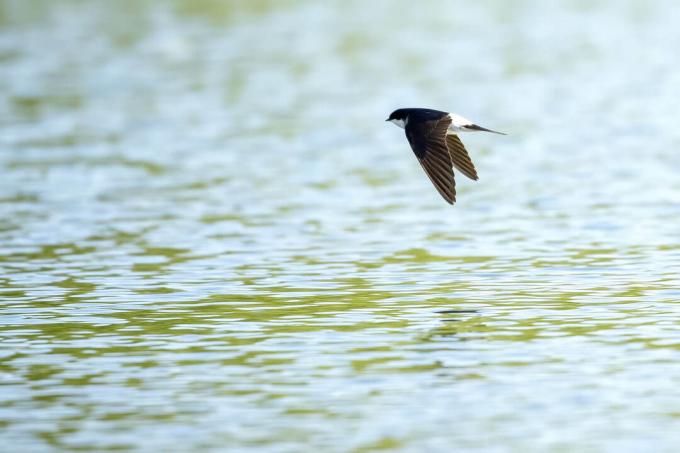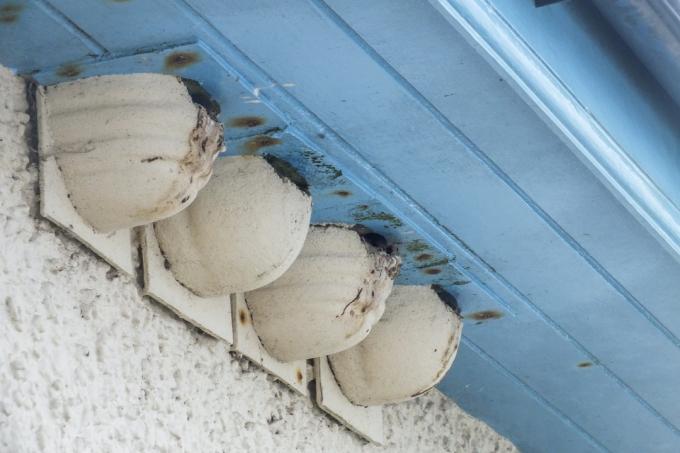Would you like to know how you can attract house martins or how to tell the difference between the house martin and the barn swallow? You can find out this and more in our special article.

The house martin (Delichon urbica / Delichon urbicum) is one of our most common species of swallow. In summer, the gifted pilots can often be seen in residential areas such as villages or towns. With their typical, swallow-like flight pattern, they whiz through the air in search of food and nest under the roofs of buildings. They can also often be seen performing artful flight maneuvers over bodies of water. How to recognize a house martin, how to distinguish it from other species and how you can offer the flight artists a home, you can find out here in our large profile.
contents
- House martin: wanted poster
-
This is how you recognize the house martin
- What is the difference between male and female house martins?
- What does house martin singing sound like?
- How do you recognize a house martin young bird?
- What do house martin eggs look like?
- What is the difference between the house martin and the barn swallow?
- Which habitat do the house martins prefer?
- Where does the house martin build its nest?
- When is the house martin breeding season?
- Where does the house martin spend the winter?
-
Support the house martin in the garden: this is how it works
- What do house martins eat?
- Which nesting boxes are suitable for house martins?
- How can you give the house martin additional support?
House martin: wanted poster
| size | Approx. 12 - 13 cm |
| weight | About 20 g |
| Breeding season | April - September |
| lifespan | Up to 14 years |
| habitat | Open landscapes, settlements, cities |
| Feed preference | Flying insects |
| Threats | Insect decline, loss of nesting opportunities |
This is how you recognize the house martin
House martins are most commonly seen in flight. Then they show their pointed wings and the typical forked tails of the swallows. House martins are clearly recognizable by their monochrome, light underside and the black, blue, shiny upper side. Another important feature is the white lower back, also known as the rump, which in flight contrasts wonderfully with the otherwise dark upper side.

What is the difference between male and female house martins?
Male and female house martins are very difficult to tell apart. The only difference between the sexes is that the females have a slightly dirty white throat, while that of the males is pure white. However, this feature is very unreliable and almost invisible to the untrained eye - and not even to experts in flight.
What does house martin singing sound like?
The song of the house martin cannot necessarily be compared to the melodious song of other songbirds. It consists more of an unstructured, chattering chirp, but it sounds bright and eager. In flight, the house martins also call out a happy "Prrrriet".
You can find out what the house martin singing sounds like in this sound recording:
How do you recognize a house martin young bird?
Young house martins are already the image of their parents and can therefore be recognized early on by the high contrast between the bottom and top and the white rump. What they are still missing, however, is the metallic blue sheen in the plumage. The feathers of the young birds are still very dull and uniformly dark. In addition, the belly plumage is a bit dirty and especially the throat a bit darker than that of the adult animals.

What do house martin eggs look like?
House martins lay between three and five eggs that are about 2 centimeters in size and pure white. The eggs are laid in a nearly completely closed nest made of clay and attached to the outside of buildings. The inside of the nest is padded with fine blades of grass or feathers.
What is the difference between the house martin and the barn swallow?
In addition to the house martins, they also belong Barn swallows one of our most common domestic swallows. The two species can often be seen in the same areas and even hunt insects together. However, they are very easy to distinguish. In contrast to house martins, barn swallows have a dark throat and a brown-red face. In addition, they do not have a white rump and their tail tips are very long and thin, while the fork tail of the house martin is rather short and compact.
Note: At long distances, the altitude can also help to differentiate the two species. House martins hunt their insects at a height of about 20 meters, while barn swallows usually only climb seven to eight meters high. However, this is not an iron rule and of course it happens that house martins also hunt in deeper layers of the air.

Which habitat do the house martins prefer?
House martins are very diverse when it comes to their habitat. They occur in numerous open and semi-open landscapes - also in the mountains and in city centers. When choosing a habitat, it is important to have a rich supply of insects, which is why the swallows prefer a body of water nearby. In addition, suitable nesting opportunities are important, which the swallows find on the facade of buildings or on rock walls.
Where does the house martin build its nest?
The house martin always builds its nest under an overhang. This can be a natural ledge, but also a roof overhang or the substructure of a concrete bridge or a balcony. The nests are made of clay, are hemispherical and have only one small entrance hole. Old nests are often reused - both by swallows and by other cave breeders such as House Sparrows or titmice.
House martins also like to breed in colonies, which is why several swallow nests are often built next to each other at one nesting site.

When is the house martin breeding season?
The nesting season of the house martins extends from April to September. With the brooding itself, the two partners take turns regularly. Males and females incubate the eggs for 14 to 16 days. Then the young swallows hatch and are fed with lots of flying insects by both parents until they are big enough to leave the nest. This can take up to 30 days. Then the young birds make their first attempts to fly, but still stay near the nest. In the first few weeks, their parents also help them to find food. After that, however, the little ones are on their own and the adults often start with a second brood.
Where does the house martin spend the winter?
House martins only spend their breeding season with us. In the late year they head south to avoid the cold winter months. Since the swallows are dependent on the supply of flying insects, they would starve to death with us. That is why they winter south of the Sahara, where they find enough food in the rainforests of Africa.

Support the house martin in the garden: this is how it works
House martins find it increasingly difficult to build their nests on newfangled smooth facades. Often they are driven away on purpose or their nests destroyed. If you want to provide a home for the native birds, you will find out everything you need to know about nesting boxes, food and other aids here.

What do house martins eat?
House martins only feed on flying insects. You are therefore not interested in the offered scatter feed or similar, well-intentioned feed aids. But that does not mean that you cannot support the swallows in their daily struggle for food. The motto here is: Insect protection is bird protection. You should therefore refrain from using insect-damaging pesticides in your own garden as well as when shopping. Because when you buy organic products, you promote sustainable and ecological agriculture that provides habitat and food for our native birds.
If you want to take it a step further and bring extra life to your garden then you can create a meadow with local flowers and herbs that make insects and birds equally happy will. With our Plantura beneficial insect magnet You can do this very easily, by the way. With this seed mixture you can quickly and easily create a little paradise for a large number of small gardeners. And you can do more by yourself bird-friendly native shrubs plant and design your garden as close to nature as you can.
Which nesting boxes are suitable for house martins?
House martins are also happy to accept artificial nesting aids. However, these look a little different than the typical tit boxes. House martin boxes are usually hemispherical and - like the natural nest - closed all around except for a small entrance hole. You can attach the nesting aids to the outside of a house wall or garage. However, do remember to clean the nest boxes once a year. This will prevent the accumulation of dirt and parasites and increase the birds' chances of survival. The best time to do this is towards the end of winter, before the swallows return from their wintering areas in April.
Tip: A manure board, which is attached below the nesting box, avoids a dirty facade.

How can you give the house martin additional support?
If you prefer to give the house martins the opportunity to build their own nest, you can achieve a lot by offering clayey soil. Because the nesting material is not always easy to obtain and especially in dry times it is in short supply. You can therefore attract the birds by creating a small puddle in the garden. If your soil is rather sandy, you also have the option of offering loamy soil in a small bowl with a little water.

And if you still need a second bowl, it is a good idea to set up a pure water point right away. Because on hot summer days all garden birds look forward to cooling off. However, be sure to clean the waterhole regularly to prevent the spread of infectious diseases. Especially at high temperatures, the risk of pathogens multiplying in the water increases - it is best to clean your water point every day during this time.
If you have caught bird fever and would like to find out more about garden birds, then take a look at our other species portraits Goldhammer, magpie & Co. over.
